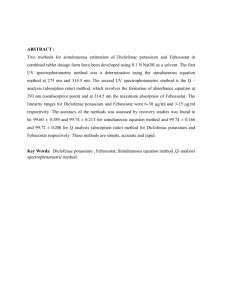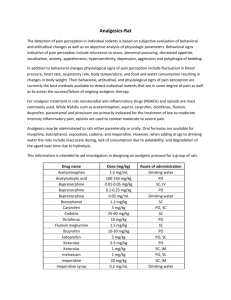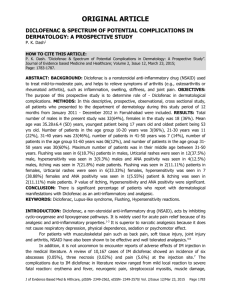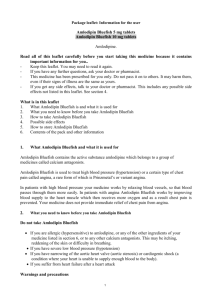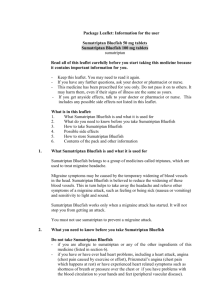Diclofenac Bluefish gastro
advertisement
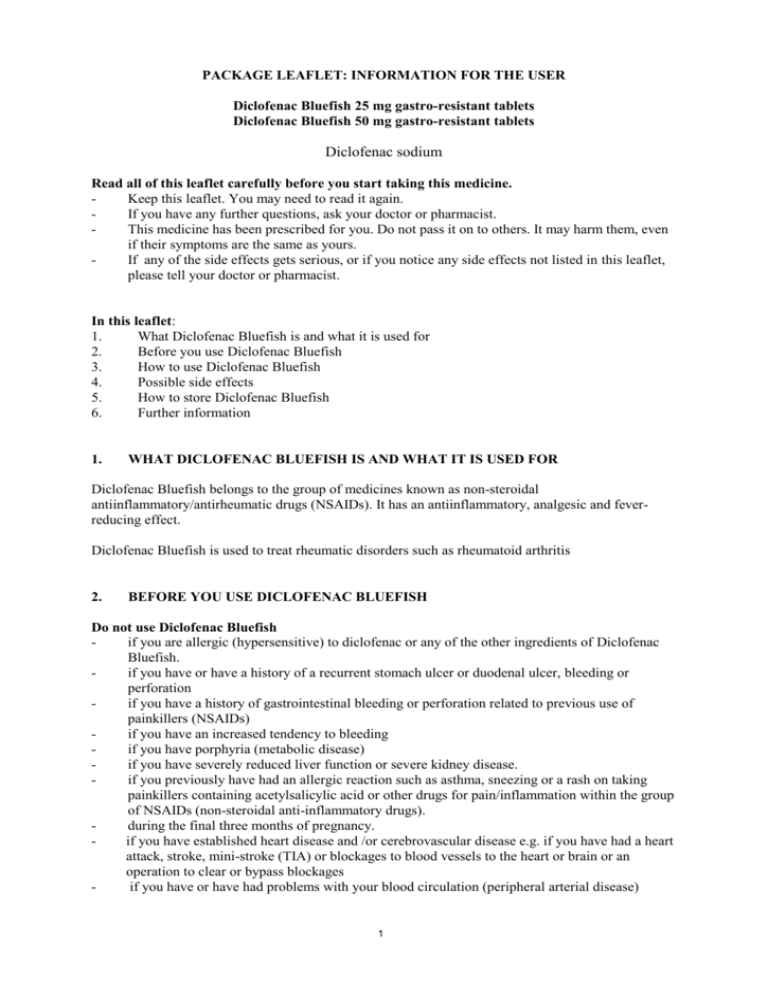
PACKAGE LEAFLET: INFORMATION FOR THE USER Diclofenac Bluefish 25 mg gastro-resistant tablets Diclofenac Bluefish 50 mg gastro-resistant tablets Diclofenac sodium Read all of this leaflet carefully before you start taking this medicine. Keep this leaflet. You may need to read it again. If you have any further questions, ask your doctor or pharmacist. This medicine has been prescribed for you. Do not pass it on to others. It may harm them, even if their symptoms are the same as yours. If any of the side effects gets serious, or if you notice any side effects not listed in this leaflet, please tell your doctor or pharmacist. In this leaflet: 1. What Diclofenac Bluefish is and what it is used for 2. Before you use Diclofenac Bluefish 3. How to use Diclofenac Bluefish 4. Possible side effects 5. How to store Diclofenac Bluefish 6. Further information 1. WHAT DICLOFENAC BLUEFISH IS AND WHAT IT IS USED FOR Diclofenac Bluefish belongs to the group of medicines known as non-steroidal antiinflammatory/antirheumatic drugs (NSAIDs). It has an antiinflammatory, analgesic and feverreducing effect. Diclofenac Bluefish is used to treat rheumatic disorders such as rheumatoid arthritis 2. BEFORE YOU USE DICLOFENAC BLUEFISH Do not use Diclofenac Bluefish if you are allergic (hypersensitive) to diclofenac or any of the other ingredients of Diclofenac Bluefish. if you have or have a history of a recurrent stomach ulcer or duodenal ulcer, bleeding or perforation if you have a history of gastrointestinal bleeding or perforation related to previous use of painkillers (NSAIDs) if you have an increased tendency to bleeding if you have porphyria (metabolic disease) if you have severely reduced liver function or severe kidney disease. if you previously have had an allergic reaction such as asthma, sneezing or a rash on taking painkillers containing acetylsalicylic acid or other drugs for pain/inflammation within the group of NSAIDs (non-steroidal anti-inflammatory drugs). during the final three months of pregnancy. if you have established heart disease and /or cerebrovascular disease e.g. if you have had a heart attack, stroke, mini-stroke (TIA) or blockages to blood vessels to the heart or brain or an operation to clear or bypass blockages if you have or have had problems with your blood circulation (peripheral arterial disease) 1 Take special care with Diclofenac Bluefish Side effects may be minimised by using the lowest effective dose for the shortest duration necessary. Higher doses than the recommended dose are generally associated with an increased risk of side effects. Seek advice from your doctor before treatment if you have or have had any of the following diseases: gastrointestinal problems or heartburn/ discomfort in the stomach or a history of gastric or intestinal ulceration, bleeding or perforation - liver disease or kidney disease asthma, chronic obstructive pulmonary diseases or chronic infections of the respiratory tract inflammation of the nasal mucous membranes SLE (connective tissue disease) diseases that result in an increased tendency to bleed angina, blood clots, high blood pressure, ulcerative colitis or Crohn’s disease diabetes Make sure your doctor knows, before you are given diclofenac - If you smoke - If you have raised cholesterol or raised triglycerides Elderly persons should be aware of the greater risk of side effects that comes with increasing age. As with other anti-inflammatory agents, allergic reactions, including anaphylactic reactions can occur in rare cases with Diclofenac Bluefish without earlier exposure to the drug. Serious skin reactions have been reported very rarely in association with the use of NSAIDs. Stop using Diclofenac Bluefish if you get any skin rash or any other sign of hypersensitivity and contact a doctor. During varicella (chicken pox) it is advisable to avoid use of this drug. If you get gastrointestinal problems, discontinue to take Diclofenac Bluefish and seek advice from a doctor. Prolonged use of any type of painkiller for headaches can make the headache worse. If this situation is experienced or suspected, medical advice should be obtained and treatment should be discontinued. Like other anti-inflammatory agents, Diclofenac Bluefish can mask the signs or symptoms of infection. Medicines such as Diclofenac Bluefish may be associated with a small increased risk of heart attack (‘‘myocardial infarction’’) or stroke. Any risk is more likely with high doses and prolonged treatment. Do not exceed the recommended dose or duration of treatment. Diclofenac Bluefish can make it more difficult to conceive, please refer to the section pregnancy and breast-feeding for further information. Using other medicines Please tell your doctor or pharmacist if you are taking or have recently taken any other medicines, including medicines obtained without a prescription. Certain medicines may be affected by treatment with Diclofenac Bluefish, for example: - medicines against blood clots (warfarin, ticlopidine, acetylsalicylic acid, heparin etc.), - medicines against tumours and disturbances of the immune system (such as methotrexate), - medicines for treating diabetes, except for insulin, 2 - - lithium (used for manic depression) SSRIs (used for depression), digoxin (used for heart problems), cyclosporin (used during transplantations, for severe psoriasis and for rheumatism), certain medicines for high blood pressure (beta-blockers, angiotensin II receptor antagonists and ACE inhibitors), diuretics (agents to stimulate urine production, and used against high blood pressure), quinolone antibiotics (used for urinary tract infection), zidovudine (used in the treatment of HIV infection), corticosteroids (used to treat inflammatory diseases), colestipol or colestyramine (used to treat high levels of blood fat). These medicines can be used together with diclofenac if diclofenac is taken at least 1 hour before or 4 to 6 hours after the intake of colestipol/colestyramine. tacrolimus (used to treat some inflammatory diseases and after transplants) sulfinpyrazone (a medicine used to treat gout) fluconazole or voriconazole (used for fungal infections), rifampicin (an antibiotic used for tuberculosis), carbamazepine (used for epilepsy), barbiturates (sleeping agents), diazepam (a sedative), pentoxifylline (an agent to dilate blood vessels), phenytoin (used for epilepsy). Never take several different pain-relief medicines at the same time without first consulting your doctor or pharmacist. Using Diclofenac Bluefish with food and drink Gastro-resistant tablets must be swallowed whole with plenty of fluid (at least 1½ glasses of water). For maximum effect, the tablets are not to be taken with or directly after a meal. Pregnancy and breast-feeding Diclofenac Bluefish must not be used during the last three months of the pregnancy. Diclofenac Bluefish should be avoided by women who are trying to become pregnant or who are pregnant. Treatment with Diclofenac Bluefish during any phase of pregnancy may only take place on the prescription of a doctor. Diclofenac passes into the breast-milk in small amounts.Therefore, Diclofenac Bluefish should not be used during breast-feeding. Taking Diclofenac Bluefish can make it more difficult to conceive.Seek advice from your doctor if you are planning to become pregnant or if you are having problems in becoming pregnant.The effect is temporary and ceases when you stop taking these types of drugs. Driving and using machines Diclofenac Bluefish can cause visual disturbances, dizziness and drowsiness. If you experience any of these effects, or any other central nervous system disturbances, you should avoid driving or using machines. Important information about some of the ingredients of Diclofenac Bluefish Diclofenac Bluefish enteric-coated tablets contain lactose monohydrate. If you do not tolerate certain types of sugar, you should contact your doctor before taking this medicine. 3. HOW TO USE DICLOFENAC BLUEFISH 3 Always use Diclofenac Bluefish exactly as your doctor has told you. You should check with your doctor or pharmacist if you are not sure. Rheumatic disorders Usual dose for adults: 75-150 mg daily divided into 2-3 doses depending on disease activity. Note that the total dose during any 24-hour period should not exceed six 25 mg tablets or three 50 mg tablets. Gastro-resistant tablets must be swallowed whole with at least 1½ glass of water. If you find that Diclofenac Bluefish has too strong or too weak effect, contact your doctor or pharmacist. If you take more Diclofenac Bluefish than you should: If you have taken more Diclofenac Bluefish than you should, or if children have been taking medicine by accident, please contact your doctor or the hospital to get an opinion of the risk and advice on action to be taken. Symptoms of an overdose can include: nausea (feeling sick), vomiting, abdominal pain, gastrointestinal bleeding, diarrhoea, dizziness, drowsiness, headache, ringing in the ears (tinnitus), anxiety, hallucinations, convulsions and swollenness. If you forget to take Diclofenac Bluefish: Do not take a double dose to make up for a forgotten dose. If you have any further question on the use of this product, ask your doctor or pharmacist. 4. POSSIBLE SIDE EFFECTS Like all medicines, Diclofenac Bluefish can cause side effects, although not everybody gets them. You may experience gastrointestinal problems at the beginning of treatment. These side effects normally disappear within a few days. Some side effects can be serious If you suffer from any of the following at any time during your treatment STOP TAKING DICLOFENAC BLUEFISH and seek immediate medical help: Agranulocytosis (symptoms: fever, sore throat, painful mouth ulcers, anal ulcers, reduced immune reponse, prone to bacterial infections). Stevens-Johnson syndrome and toxic epidermal necrolysis (Life-threatening skin diseases that cause rash, skin peeling, and sores on the mucous membranes). Hypersensitivity reactions (narrowing and obstruction of the respiratory airway, hives, allergic shock reaction with a fall in blood pressure). You should stop taking Diclofenac Bluefish and see your doctor immediately if you experience symptoms of angioedema,such as swollen face,tongue or pharynx,difficulty to swallow,hives and difficulties to breathe. Common (affects 1 to 10 users in 100): Abdominal pain, nausea, vomiting, diarrhoea, digestive problems, reduced appetite, gases in the stomach, headache, dizziness, rash and raised liver values. Uncommon (affects 1 to 10 users in 1,000): Tiredness and bronchospasm. Rare (affects 1 to 10 users in 10,000): Hypersensitivity, anaphylactic reactions (severe hypersensitivity reactions which may lead to breathing difficulty and shock (strong decrease in blood pressure, paleness, agitation, weak and fast pulse, clammy skin, and decreased consciousness)), 4 asthma (including difficulties to breathe), drowsiness, swelling of the body as a result of fluid retention, gastritis, bleeding or ulcers in the gastrointestinal tract, vomiting blood, black stools, liver function disorders (liver inflammation, yellowing of the skin), nettle rash., impotence (the association here is uncertain). Very rare (affects less than 1 user in 10,000): Angioneurotic oedema (rapid swelling of the skin and mucosa), effects on vision (blurred vision, double vision) and hearing (reduced hearing, tinnitus), effects on blood composition (a reduced number of blood platelets, which can lead to small bleeding in the skin and mucous membranes, a reduced number of white blood cells, which can degrade the immune response, breakdown of red blood cells and anaemia), disorientation, depression, difficulties in sleeping, nightmares, irritability, anxiety, a disturbed sense of reality, abnormal skin sensation (i.e tingling or numbness), memory impairment, convulsions (involuntary contraction of the muscles), shaking movement often noticed in hands and arms (tremor), changes in the sense of taste, aseptic meningitis, stroke, effects on the heart and blood vessels (such as chest pains, sensation of a irregular and/or forced beating of the heart, heart failure, myocardial infarction, high blood pressure, vasculitis (inflammation of the blood vessels)), inflammation of the lungs, problems with the large intestine, constipation, inflammation of the oral mucosa, tongue or pancreas, intestinal strictures, lower gut disorders (including inflammation of the colon, or worsening of ulcerative colitis or Crohn’s disease), oesophageal disorder, liver function disorders, (including fulminant liver inflammation, hepatic necrosis and hepatic failure), eczema, redness of the skin, exfoliative dermatitis, hair loss, hypersensitivity to light, itching, purpura (skin bleedings), bullous skin reactions (including StevensJohnson Syndrome and toxic epidermal necrolysis), effects on the kidneys (such as kidney failure and blood or proteins in the urine). Stomach bleeding can occur at any time during treatment with or without warning symptoms. This generally has more serious consequences in elderly patients. A doctor must be contacted if this occurs, or if any other unexpected symptoms occur. Exceptional serious infections of the skin in case of varicella (chicken pox). Diclofenac Bluefish may cause a reduction in the number of white blood cells and your resistance to infection may be decreased. If you experience an infection with symptoms such as fever and serious deterioration of your general condition, or fever with local infection symptoms such as sore throat/pharynx/mouth or urinary problems you should see your doctor immediately. A blood test will be taken to check possible reduction of white blood cells (agranulocytosis). It is important to inform your doctor about your medicine. If any of the side effects gets serious, or if you notice any side effects not listed in this leaflet, please tell your doctor or pharmacist. 5. HOW TO STORE DICLOFENAC BLUEFISH Keep out of the reach and sight of children. Do not use Diclofenac Bluefish after the expiry date which is stated on the carton after EXP. Do not store above 25°C. Medicines should not be disposed of via wastewater or household waste. Ask your pharmacist how to dispose of medicines no longer required. These measures will help to protect the environment. 6. FURTHER INFORMATION What Diclofenac Bluefish contains - The active substance is diclofenac sodium 25 mg or 50 mg 5 - The other ingredients are lactose monohydrate, magnesium stearate, microcrystalline cellulose, pregelatinised starch, sodium starch glycolate, maize starch, macrogol, methacrylic acid-ethyl acrylate copolymer, dimethicone, polysorbate 80, sorbic acid, talc and colourings (25 mg: yellow iron oxide E172, titanium dioxide E171; 50 mg: red and yellow iron oxide E172, titanium dioxide E171) What Diclofenac Bluefish looks like and contents of the pack 25 mg gastro-resistant tablets: Domed film-coated yellow tablets, 7 mm in diameter, marked D 25. 50 mg gastro-resistant tablets: Domed film-coated brown tablets, 8 mm in diameter, marked D 50. Blister pack: 25 mg gastro-resistant tablets: 10, 20, 30, 50 and 100 50 mg gastro-resistant tablets: 10, 20, 30, 50 and 100 Not all pack sizes may be marketed. Marketing Authorisation Holder and Manufacturer Marketing authorisation holder: BMM Pharma AB Blasieholmsgatan 2 111 48 Stockholm Sweden Manufacturer: Dragenopharm Apotheker Püschl GmbH & Co KG Otto Göllstrasse 1 84529 Tittmoning Germany This leaflet was last approved in 2014-03-27 6
